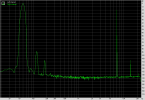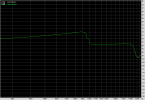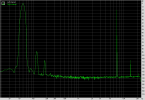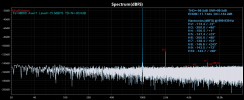Dilettante
Member
- Joined
- Jun 5, 2022
- Messages
- 87
- Likes
- 36
The interface has been on the market for quite some time, however there is still no review on ASR. My intention is to rectify this.
I won't be adding any photos to the post as these are readily available over the Internet.
What I'd like to mention is that the volume knob is significantly less robust compared to all others. Why it was manufactured this way is a mystery to me. Especially considering that volume level does not persist between power cycles.
The measurements were performed using balanced cable in loopback mode. Sample rate and other relevant settings are clearly visible on the screenshots.
1KHz sine
Note the improved harmonics when preamp is at ~11 o'clock. Counterintuitively, harmonics are better in the 2nd example.
Multitone
Level sweeps
What the **** ? With the preamp turned on, TD+N goes up and down starting from -23 to -10dB.
All measurements were taken using ASIO in 24b / 48kHz.
Given the single-channel cable, I am not sure if the stereo crosstalk should be even looked at.












I hope this was useful to you. This is my first review and I am grateful for all the knowledge generously shared by the members of this forum.
I won't be adding any photos to the post as these are readily available over the Internet.
What I'd like to mention is that the volume knob is significantly less robust compared to all others. Why it was manufactured this way is a mystery to me. Especially considering that volume level does not persist between power cycles.
The measurements were performed using balanced cable in loopback mode. Sample rate and other relevant settings are clearly visible on the screenshots.
Multitone
I would like to thank mr. @pkane for his excellent Multitone software.
1KHz sine
| Line input | |
|
|
Note the improved harmonics when preamp is at ~11 o'clock. Counterintuitively, harmonics are better in the 2nd example.
Multitone
| Line input | Preamp at 11 |
Level sweeps
| Line input | Microphone preamp at 11 |
What the **** ? With the preamp turned on, TD+N goes up and down starting from -23 to -10dB.
RMAA
All measurements were taken using ASIO in 24b / 48kHz.
Line input
| Frequency response (from 40 Hz to 15 kHz), dB | +0.04, -0.04 | Excellent |
| Noise level, dB (A) | -114.8 | Excellent |
| Dynamic range, dB (A) | 115.0 | Excellent |
| THD, % | 0.00479 | Very good |
| THD + Noise, dB (A) | -84.0 | Good |
| IMD + Noise, % | 0.00530 | Excellent |
| Stereo crosstalk, dB | -57.8 | Average |
| IMD at 10 kHz, % | 0.00580 | Excellent |
Given the single-channel cable, I am not sure if the stereo crosstalk should be even looked at.
Frequency response
Nothing to discuss here, flat.
Left | Right | |
| From 20 Hz to 20 kHz, dB | -0.10, +0.05 | -0.10, +0.05 |
| From 40 Hz to 15 kHz, dB | -0.04, +0.04 | -0.04, +0.04 |
Noise level
Perfectly usable for any practical purpose.
Left | Right | |
| RMS power, dB | -113.0 | -113.0 |
| RMS power (A-weighted), dB | -114.8 | -114.8 |
| Peak level, dB FS | -76.7 | -76.7 |
| DC offset, % | -0.0 | -0.0 |
Dynamic range
Left | Right | |
| Dynamic range, dB | +113.9 | +113.9 |
| Dynamic range (A-weighted), dB | +115.0 | +115.0 |
| DC offset, % | -0.00 | -0.00 |
THD + Noise (at -3 dB FS)
Left | Right | |
| THD, % | 0.00479 | 0.00479 |
| THD + Noise, % | 0.00485 | 0.00485 |
| THD + Noise (A-weighted), % | 0.00629 | 0.00629 |
Intermodulation distortion
Comments on 60Hz and ~7.5kHz anomalies would be appreciated.
Left | Right | |
| IMD + Noise, % | 0.00530 | 0.00530 |
| IMD + Noise (A-weighted), % | 0.00397 | 0.00397 |
IMD (swept tones)
I do not know what is happening here.
Left | Right | |
| IMD + Noise at 5000 Hz, | 0.00872 | 0.00872 |
| IMD + Noise at 10000 Hz, | 0.00495 | 0.00495 |
| IMD + Noise at 15000 Hz, | 0.00372 | 0.00372 |
Microphone preamp at ~11 o'clock
Again, some numbers are better than the line input!
| Frequency response (from 40 Hz to 15 kHz), dB | +0.04, -0.04 | Excellent |
| Noise level, dB (A) | -111.5 | Excellent |
| Dynamic range, dB (A) | 111.6 | Excellent |
| THD, % | 0.00083 | Excellent |
| THD + Noise, dB (A) | -96.5 | Excellent |
| IMD + Noise, % | 0.00148 | Excellent |
| Stereo crosstalk, dB | -55.3 | Average |
| IMD at 10 kHz, % | 0.00135 | Excellent |
Frequency response
Left | Right | |
| From 20 Hz to 20 kHz, dB | -0.10, +0.05 | -0.10, +0.05 |
| From 40 Hz to 15 kHz, dB | -0.04, +0.04 | -0.04, +0.04 |
Noise level
Left | Right | |
| RMS power, dB | -110.1 | -110.1 |
| RMS power (A-weighted), dB | -111.5 | -111.5 |
| Peak level, dB FS | -75.1 | -75.1 |
| DC offset, % | -0.0 | -0.0 |
Dynamic range
Left | Right | |
| Dynamic range, dB | +110.5 | +110.5 |
| Dynamic range (A-weighted), dB | +111.6 | +111.6 |
| DC offset, % | -0.00 | -0.00 |
THD + Noise (at -3 dB FS)
Harmonics are strikingly better compared to the line input.
Left | Right | |
| Dynamic range, dB | +110.5 | +110.5 |
| Dynamic range (A-weighted), dB | +111.6 | +111.6 |
| DC offset, % | -0.00 | -0.00 |
Intermodulation distortion
The same 60Hz and 7.5kHz spikes, however 100-200Hz and ~15kHz are better.
Left | Right | |
| IMD + Noise, % | 0.00148 | 0.00148 |
| IMD + Noise (A-weighted), % | 0.00121 | 0.00121 |
IMD (swept tones)
Less deviation with amplifier compared to the plain DAC? New word in engineering? Glitch? UFO?..
Left | Right | |
| IMD + Noise at 5000 Hz, | 0.00158 | 0.00158 |
| IMD + Noise at 10000 Hz, | 0.00126 | 0.00126 |
| IMD + Noise at 15000 Hz, | 0.00121 | 0.00121 |
I hope this was useful to you. This is my first review and I am grateful for all the knowledge generously shared by the members of this forum.
Attachments
Last edited:





